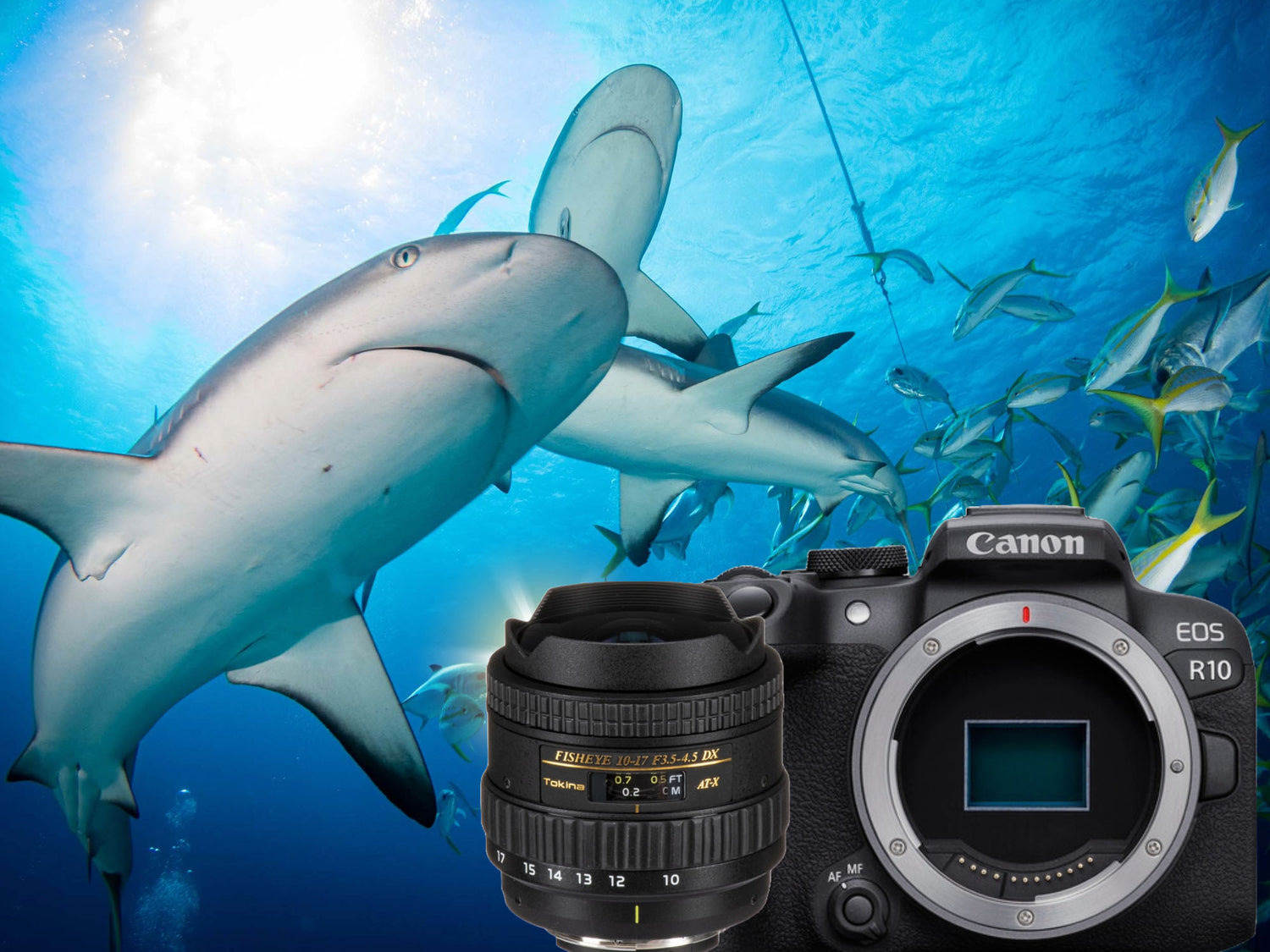By Steve Miller
The Best $475 I Ever Spent...

The extremely short minimum focusing distance of the Tokina 10-17mm lens allows you to use the Close focus wide angle (CFWA) technique to shoot interesting perspectives on traditional macro subjects. • Canon R10 • 13mm • f/18 • 1/125 © Steve Miller
In the early aughts as I was switching from film cameras to digital, everything was confusing. I asked an underwater photo pro named David Haas what lens I should buy that would be like my old Nikonos 15mm. I remember his words: “You should just get the Tokina 10-17mm Fisheye… that lens has won the wide angle category of more photo contests than all the others combined.” I had never heard of Tokina at the time but I went out and bought one for $475.

I almost take a minute on each dive to shoot near the surface of the water just under the boat. • Canon R10 • 10mm • f/3.5 • 1/25 © Steve Miller
Looking at Lightroom now, I see that I have used this same lens on over 15 different cameras. I have captured (and saved) over 50,000 images from this same (old) lens.
As I have been actively testing and shooting each of the latest cameras for Ikelite over the last 14 years- I’ve had the opportunity to try many, many lenses… Lightroom tells me I have tried 116 different lenses during this time, but I hardly remember them all. The Tokina is still my favorite lens (although I’m equally happy shooting the Canon 8-15mm Fisheye).

A super wide-angle fisheye lens is great for shooting split shots where the dome is half-in, half-out of the water. • Canon R10 • 11mm • f/9 • 1/400 © Steve Miller
Why Use a Fisheye Lens Underwater
Why do I like it so much? For one thing, it is small and lightweight. It assembles with a dome port without any port extensions, making the buoyancy and balance very easy to handle in the water. But the main reason is that it works every time. This has as much to do with the fact that it is a fisheye lens. Fisheye lenses work better behind dome ports, although explaining the laws of optics is beyond me.

When shooting the Tokina 10-17mm try to shoot as close as possible and at an upward angle. This trumpetfish was just about touching the front of my dome. • Canon R10 • 13mm • f/18 • 1/125 © Steve Miller
When I say a lens “works” I mean it will focus quickly and keep the image razor sharp. “Working” to me means that when I pull the shutter release, the camera shoots immediately- and the image is in sharp focus.
Shouldn’t all lenses do this? Yes! But when we put a lens in a housing behind a port, and submerge it- we are changing the lens. We are changing the optical elements that create the image. I have shot with many lenses that are gorgeous for topside photography, but simply don’t work well underwater. The most common issues is not being able to focus closely enough to account for the virtual image created by refraction. Lenses with a long working distance are great for birds but really suck for underwater life.

Some people swear by rectilinear lenses for big animal photography, but I'll always grab a fisheye. There's less distortion effect than you would imagine when shooting natural objects through a dome port. • Canon R10 • 12mm • f/14 • 1/125 © Steve Miller
The fisheye lens was developed to represent the way a fish sees underwater. Though the early fisheye lenses were used for observations of clouds rather than sea creatures. (They also lend themselves well to shooting the Milky Way at night.) Fisheye lenses are super wide, collect a lot of light, and are capable of focusing so close that they can lock on the inside of your dome port if there is a piece of lint or dog hair inside. But this is a good thing… There is nothing more frustrating than having a subject let you get super close for a wonderful frame, but miss the shot because the lens is struggling to focus.

Fisheye lenses can be used on shipwrecks too. The position of a line in relation to the frame will affect the amount of warping effect. • Canon R10 • 10mm • f/11 • 1/160 © Steve Miller
More Natural Than Rectilinear
A lot of excellent photographers will disagree with me, and many prefer rectilinear lenses. I believe the main reason is that when you look through one in the camera store, the distortion of straight lines is noticeable to the point of distraction... ugly even. This is mainly because you are looking at man-made shapes, full of parallel and perpendicular lines. Nature doesn’t have many straight lines. A fisheye makes the natural world look beautiful. And with almost 180 degrees of coverage, they let you get more into your scene compared to a lens with a longer focal length.

Underwater you can even make the argument that a fisheye lens makes the environment look even more natural. Keep in mind that human sight is nearly 180º including your peripheral vision. The fisheye effect can be used to immerse the viewer into an environment and show the underwater world in a way closer to the way we imagine it… perhaps closer to the way we actually see it.

You probably don't want to go out shooting pygmy seahorses with it, but you don't have to completely give up on macro photography when shooting the Tokina 10-17mm. • Canon R10 • 17mm • f/11 • 1/125 © Steve Miller
Adapting the Tokina 10-17mm to a Modern Mirrorless Camera
Using a lens I originally bought for a Nikon D100 (2002) on everything from a Sony a7R III (2017) to a Canon EOS R10 (2022) is kind of funny, and a rare thing, but then again we always used to say “it’s all about the glass.” With the new formats you will use an adapter: Metabones for Sony or the EF-EOS R Mount Adapter for Canon. I have never experienced a performance shift shooting stills with these adapters. Every photo in this article was taken on the Canon EOS R10 and the lens performs flawlessly… for photos. There is no continuous autofocus when shooting video, so you’ll want to upgrade to a native lens if you’re primary purpose is videography.

Shots taken at a great distance with a fisheye lens will lack color and contrast. Converting them to black and white can turn them into something more impressive. • Canon R10 • 12mm • f/6.3 • 1/160 © Steve Miller
Lightroom® Lens Correction with the Tokina 10-17mm Fisheye
When you import images into Lightroom there is a box to check to “allow lens correction” that you probably have never noticed. With a fisheye- particularly the 8-15mm shot at 8mm with a circular shape, this box will offer you some wonderful ways to shift your composition slightly. I suggest making sure it is un-checked for the import, but use it selectively as part of your edit.

The Tokina 10-17mm is by far the most-used lens in my Backyard Underwater Photo Studio... and in my Lightroom catalog with over 50K images logged across dozens of different camera bodies. • Canon R10 • 10mm • f/8 • 1/100 © Steve Miller
Conclusion
Before I asked David about a super wide lens, I had done a trip with the kit lens for my old Nikon D100… its focal range was 24-70mm. My favorite macro range (60mm) is in there, and 24mm is pretty wide, right? All in one lens! Nirvana I thought!
No, it was terrible.
One of the challenges of designing housings is that we are compelled to buy and test virtually every new camera or lens that comes out. Everyone wants a “do everything” lens, but it doesn’t exist. Even the most expensive optics designed specifically for underwater typically have some major concessions when you look under the hood- weight, clumsy handling, cost, color shifting, or softness at some point in the zoom range.

The fisheye lens provides a beautiful representation of this elkhorn coral which spreads across the image from edge-to-edge. I find that the distortion of the lens and the distortion of a dome port underwater almost seem to cancel each other out. • Canon R10 • 11mm • f/5.6 • 1/160 © Steve Miller
My advice is to seek out the images you like, then narrow your focus (pun intended) on that type of image. If it’s wide angle, then it’s hard to do better than the Tokina 10-17mm fisheye. Actually, the hardest part is finding one since it was discontinued by Tokina back in 2021. But they’re still available occasionally on resale sites like KEH, UsedPhotoPro, B&H Photo, or Adorama.
If you’re dead set on a rectilinear wide angle lens for the Canon R10, consider the RF-S 10-18mm F4.5-6.3 IS STM instead.

A lionfish is a perfect sized subject for CFWA with a fisheye lens, and with a lack of natural predators in the Caribbean they tend to let you get very close. • Canon R10 • 17mm • f/8 • 1/125 © Steve Miller
 Ambassador Steve Miller has been a passionate teacher of underwater photography since 1980. In addition to creating aspirational photos as an ambassador, he leads the Ikelite Photo School, conducts equipment testing, contributes content and photography, represents us at dive shows and events, provides one-on-one photo advice to customers, and participates in product research and development. Steve also works as a Guest Experience Manager for the Wakatobi Dive Resort in Indonesia. In his "free" time he busies himself tweaking his very own Backyard Underwater Photo Studio which he's built for testing equipment and techniques. Read more...
Ambassador Steve Miller has been a passionate teacher of underwater photography since 1980. In addition to creating aspirational photos as an ambassador, he leads the Ikelite Photo School, conducts equipment testing, contributes content and photography, represents us at dive shows and events, provides one-on-one photo advice to customers, and participates in product research and development. Steve also works as a Guest Experience Manager for the Wakatobi Dive Resort in Indonesia. In his "free" time he busies himself tweaking his very own Backyard Underwater Photo Studio which he's built for testing equipment and techniques. Read more...
Additional Reading
Wide Angle Showdown: Canon RF-S 10-18mm vs Tokina 10-17mm Underwater
Tokina 10-17mm Zoom Gear Installation // Ikelite 200DLM/D Underwater Housing [VIDEO]
Rectilinear vs Fisheye Lenses for Underwater Wide Angle Photography [VIDEO]
Why You Need a Fisheye Lens Underwater
GET the Canon 8-15mm Fisheye Before It's GONE! // Underwater Review & Results












![Canon RF 10-20mm Underwater Review [VIDEO]](http://www.ikelite.com/cdn/shop/articles/Canon_RF_10-20mm_Underwater_Review_copy.jpg?v=1729801714&width=2000)
![OM System TG-7 with FCON-T02 FISHEYE Lens!! Ikelite Underwater Results from Cayman Islands [VIDEO]](http://www.ikelite.com/cdn/shop/articles/OM_System_TG-7_Blog_Cover.jpg?v=1730841880&width=2000)